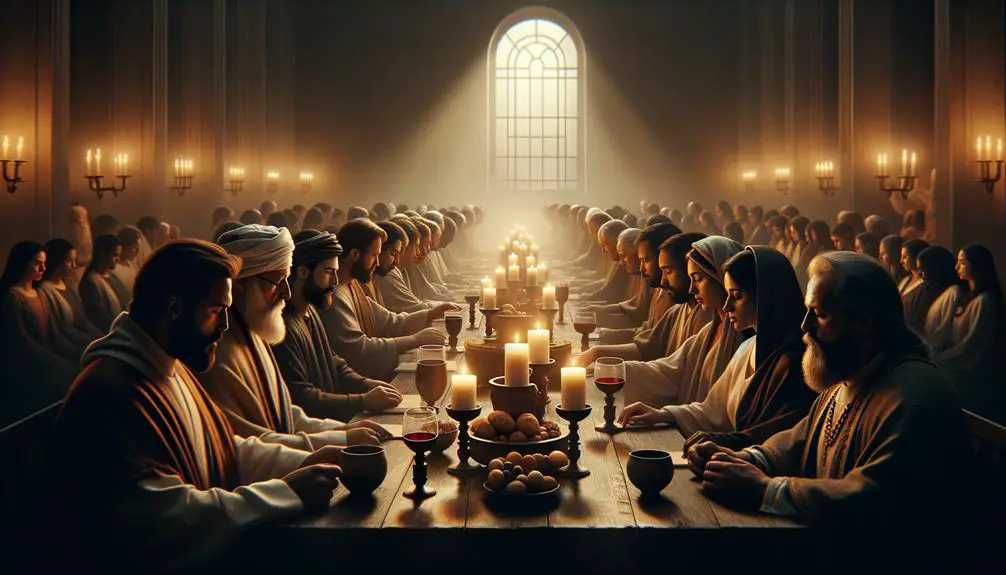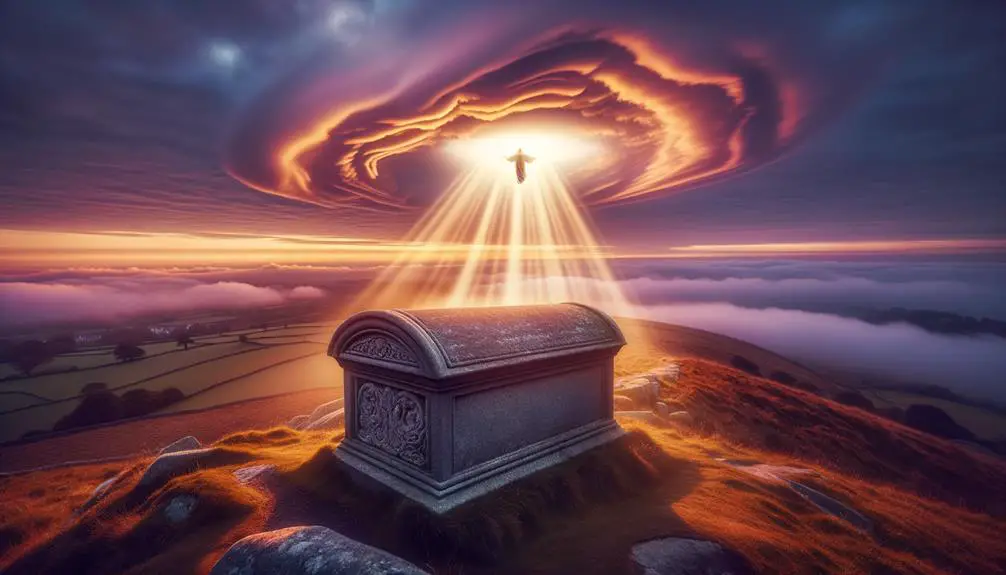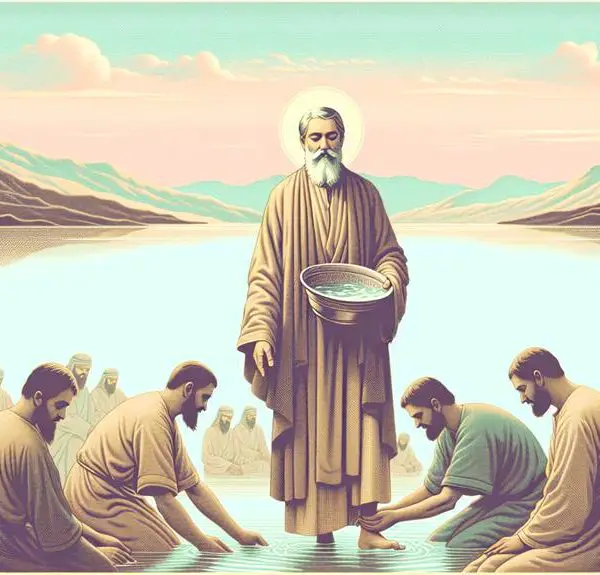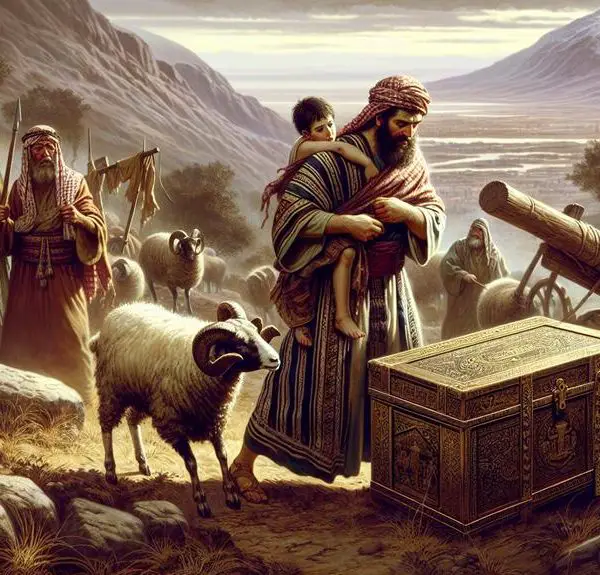Gain insights into the biblical narrative of Easter, exploring its deep symbolism and where the story unfolds, without explicitly mentioning 'Easter.

Where Is Easter Mentioned in the Bible
Much like the phoenix rises from its ashes, the story of Easter symbolizes rebirth and renewal, yet you might wonder where exactly the Bible narrates this pivotal event.
The accounts, spanning from the Last Supper to the Ascension, weave through various books, notably the Gospels, offering insights into the trial, crucifixion, and the triumphant resurrection of Jesus.
But the term 'Easter' itself isn't directly mentioned, leading to intriguing interpretations and discussions. By exploring these segments, you'll uncover layers of meaning that have captivated believers and scholars alike, inviting a deeper understanding of one of Christianity's cornerstone events.
Key Takeaways
- Easter's roots are in the Passover context, aligning with Jesus's Last Supper.
- The Garden of Gethsemane's events underscore the spiritual depth of Easter.
- Disciples' failures and betrayals highlight the human aspect of the Easter story.
- Easter is not directly mentioned but is implied through the crucifixion and resurrection narratives.
The Last Supper

The Last Supper, a pivotal event in the Christian narrative, marks Jesus Christ's final meal with his disciples before his crucifixion, embodying profound theological significance and instituting the Eucharist. This ceremonial meal, deeply rooted in the Passover context, signifies Jesus as the Lamb of God, offering himself as a sacrifice for humanity's sins. The Passover, a Jewish festival commemorating the Israelites' liberation from Egyptian slavery, provides a rich backdrop, enhancing the understanding of Jesus' actions during the Last Supper. You'll find that the Passover context isn't merely coincidental but foundational to comprehending the full depth of the Last Supper's significance.
Analyzing the Last Supper, it's crucial to recognize how Jesus reinterprets traditional Passover symbols through his words and actions. By breaking the bread and sharing the wine, declaring them as his body and blood, he inaugurates the New Covenant, which is central to Christian theology. This moment isn't just a ceremonial meal; it's a transformative event that shifts the focus from the lamb's blood, which saved the Israelites in Egypt, to Jesus' sacrifice, which offers salvation to all of humanity.
Moreover, the setting and timing of the Last Supper underscore its importance. Celebrated on the eve of Jesus' crucifixion, it serves as a deliberate farewell and a means to fortify his disciples for the challenges they'd face. The Last Supper's theological and symbolic dimensions are multifaceted, embedding it as a cornerstone in Christian faith, where the Eucharist continues to be a central ritual, commemorating Jesus' sacrifice and his message of redemption and love.
Garden of Gethsemane
As you explore the narrative of the Garden of Gethsemane, it's critical to examine Jesus's agonizing prayer, a moment that underscores his humanity and foreknowledge of impending suffering.
The disciples' inability to remain vigilant, despite Jesus's plea, highlights their human frailty and sets the stage for the subsequent betrayal.
This betrayal and arrest of Jesus, facilitated by Judas Iscariot, not only fulfills prophecy but also serves as a pivotal turning point in the Easter narrative, leading directly to the events of the crucifixion.
Jesus's Agonizing Prayer
In the shadow of impending betrayal, Jesus's agonizing prayer in the Garden of Gethsemane starkly reveals his human vulnerability and divine submission. This moment, dense with theological significance, unfolds with several key elements:
- Olive Press Symbolism: The name 'Gethsemane' translates to 'oil press,' metaphorically aligning Jesus's pressure and anguish with the process of olives being crushed to release oil, symbolizing the emergence of spiritual purity through suffering.
- Angelic Support: Amidst his distress, an angel appears to strengthen Jesus, highlighting divine intervention and support during moments of profound human weakness.
- Submission to God's Will: Jesus's prayer, 'not my will, but yours be done,' exemplifies the epitome of faith and obedience.
- Isolation: Despite being surrounded by his closest disciples, Jesus confronts his darkest hour alone, underscoring the solitary path of sacrifice.
Disciples' Failed Watch
Following Jesus's profound moment of submission in the Garden of Gethsemane, his disciples' inability to remain vigilant underscores a critical failure in human fidelity and alertness. This episode, ripe with theological significance, isn't just about physical tiredness; it symbolizes the all-too-human propensity to falter under spiritual and emotional duress.
The disciples' failed vigilance isn't merely a lapse in duty; it's a profound manifestation of human weakness, a prelude to the despair that would engulf them as events unfolded. Their inability to watch, even for an hour, juxtaposes their earlier promises of unwavering loyalty with the reality of their limitations.
This moment of weakness foreshadows the disciples' despair, deepening the narrative of betrayal and abandonment that's pivotal to the Easter story.
Betrayal and Arrest
The pivotal moment of betrayal and arrest in the Garden of Gethsemane starkly illuminates the fragility of trust and loyalty among even the closest of confidants.
To grasp the depth of this event, consider these elements:
- Judas's Motive: Was it merely greed, or did deeper disillusionment play a part?
- High Priest's Role: His influence in orchestrating the arrest underscores the religious and political tensions of the time.
- The Disciples' Reaction: A mixture of confusion, denial, and abandonment.
- The Symbolic Kiss: This act of betrayal by Judas not only identifies Jesus to the authorities but also marks the ultimate breach of trust.
In analyzing these components, you'll uncover the complex interplay of personal, religious, and political motivations behind Jesus's arrest.
Trial and Crucifixion
You'll observe that after Jesus' betrayal in Gethsemane, the narrative transitions into the legal and moral complexities of his trial, culminating in Pilate's reluctant judgment. This phase underscores the intertwining of political, religious, and social tensions leading to the crucifixion at Golgotha.
Analyzing these events reveals deeper insights into the historical and theological dimensions of Easter.
Jesus Betrayed at Gethsemane
In a pivotal moment of betrayal, Jesus's disciple Judas Iscariot led the authorities to Gethsemane, setting the stage for the trial and crucifixion that would forever alter the course of Christian history. This act wasn't just a simple betrayal; it was steeped in complex motivations and rich symbolism.
- Judas's Motivation: Often debated, motivations range from disillusionment to greed, suggesting a multifaceted character caught in a web of political and personal turmoil.
- Olive Press Symbolism: Gethsemane, meaning 'oil press,' symbolizes the immense pressure and agony Jesus faced, a poignant backdrop to Judas's betrayal.
- The Kiss of Betrayal: A sign of respect turned into the ultimate act of treachery.
- The Arrest: Marks the beginning of the end, leading directly to the trial and crucifixion.
Pilate's Reluctant Judgment
Following Judas's betrayal, Pontius Pilate found himself entangled in a judicial dilemma that would culminate in one of history's most consequential decisions: the crucifixion of Jesus Christ. The trial's backdrop was complex, steeped in Roman politics and the delicate balance of power. Pilate, wary of upsetting Roman order and the Jewish authorities, sought to navigate the treacherous political waters. He even involved Herod in the decision-making process, hoping to deflect some responsibility. Herod's role, however, did little to alleviate Pilate's predicament, highlighting the intricate interplay of authority and the quest for justice in a politically charged environment.
Emotion |
Cause |
|---|---|
Pilate's Reluctance |
Fear of political backlash |
Herod's Indifference |
Disinterest in justice |
Audience's Anticipation |
Outcome of political maneuver |
This tableau showcases the tension and uncertainty surrounding Jesus's trial and eventual crucifixion.
Crucifixion at Golgotha
After navigating the tumultuous waters of political and judicial maneuvering, Pilate ultimately handed Jesus over to be crucified at Golgotha, marking a pivotal moment in biblical history. This event underscores the intersection of Roman practices and the historical context of Jesus' execution. Consider these aspects:
- Roman Practices: Crucifixion was a Roman method of punishment, designed for maximum shame and deterrence.
- Golgotha's Significance: Known as the place of the skull, Golgotha's location outside Jerusalem's walls fulfilled Jewish prophecy.
- Political Maneuvering: Pilate's decision reflects the complex dynamics between Roman authority and Jewish leadership.
- Historical Context: This event occurred during Passover, a time of heightened religious and social tension in Jerusalem.
Understanding the crucifixion at Golgotha requires analyzing these elements to grasp its profound impact.
Burial of Jesus
Upon Jesus' death, Joseph of Arimathea, a secret disciple, requested Pilate's permission to take down the body for burial, marking a significant moment as described in biblical accounts. This request underscores the reverence and urgency with which Joseph approached Jesus' burial, highlighting his hidden yet profound faith. Pilate's consent, a notable deviation from typical Roman practices, allowed for a dignified burial, underscoring the exceptional nature of Jesus' death and its aftermath.
The burial process itself is steeped in Jewish customs, with Joseph and Nicodemus wrapping Jesus' body in linen cloths with myrrh and aloes, as per Jewish burial traditions. This act of devotion contrasts sharply with the brutality of the crucifixion, offering a moment of solemnity and respect amidst the turmoil of Jesus' final days.
Key to the burial narrative is the sealing of Jesus' tomb with a large stone, a detail that underscores the finality and solemnity of the moment. The rolling of the stone to seal the tomb was a physical and symbolic gesture, indicating that Jesus' body was laid to rest according to Jewish burial customs. This action also sets the stage for the subsequent events, as the stone becomes a focal point in the narrative of Jesus' resurrection.
Crucially, the presence of Roman guards at the tomb, as requested by the Jewish authorities, adds a layer of complexity to the burial story. Their presence aimed to prevent the disciples from stealing Jesus' body and claiming resurrection, highlighting the tension and disbelief surrounding Jesus' death. This detail enriches the narrative, providing insight into the socio-political and religious dynamics of the time.
The Empty Tomb

Despite the meticulous burial preparations and the sealing of the tomb, the discovery of the empty tomb marks a pivotal moment in the biblical narrative of Jesus' resurrection. This event not only signifies the fulfillment of prophecy but also lays the foundation for the faith of countless believers. The narratives, while varying slightly across the Gospels, converge on critical elements that underline the significance of the empty tomb.
To understand the depth of this moment, consider the following key points:
- Stone Rolled Away: The Gospels unanimously report the stone, which was meant to secure the tomb and prevent tampering, had been rolled away. This act symbolizes the breaking of the barriers between death and life, underscoring the divine intervention at play.
- Angelic Message: Each account includes an angelic presence, delivering messages of Jesus' resurrection. This angelic message serves not only as a divine confirmation of what's transpired but also as a directive for the disciples and followers to witness and spread the news of this miraculous event.
- Witnesses: The first witnesses to the empty tomb were women, a detail that adds historical credibility to the accounts, given the societal context of the time. Their role in discovering and announcing the resurrection highlights the inclusive nature of the Gospel message.
- Absence of the Body: The empty tomb, devoid of Jesus' body, stands as tangible proof of the resurrection for the disciples and for all believers. This absence shifts the narrative from death to a living faith, centered on a risen Christ.
Analyzing these elements sheds light on the theological and historical significance of the empty tomb, a cornerstone of Easter celebrations and Christian faith.
Resurrection Appearances
Following the pivotal discovery of the empty tomb, Jesus' resurrection is further affirmed through numerous appearances to his disciples and followers, which are meticulously documented across the Gospels. These post-resurrection appearances serve not only as proof of the miraculous event but also as foundational moments for the teachings and faith that spread thereafter.
One of the most compelling accounts is the journey on the Road to Emmaus, where Jesus, unrecognized at first, walks and talks with two of his followers. It's only upon breaking bread with them that their eyes are opened to his identity. This narrative underscores the transformative realization of Jesus' presence and the fulfillment of prophecy, illustrating how understanding can dawn in the most unexpected moments.
Moreover, the story of Thomas's doubt further enriches the discourse on faith and evidence. Thomas, one of the Twelve Apostles, insists on tangible proof of Jesus' resurrection, famously declaring he must see and touch the wounds of Jesus to believe. Jesus' appearance to Thomas, offering exactly what he demanded, underscores a profound teaching: faith can coexist with doubt, and belief isn't diminished by the quest for understanding. Jesus' words to Thomas, blessing those who haven't seen and yet have believed, resonate deeply within the Christian tradition, advocating for a faith that transcends the need for physical proof.
These appearances, among others, are central to the Easter narrative, illustrating not only the physical reality of Jesus' resurrection but also its profound implications for faith, understanding, and the nature of belief itself.
The Ascension

After his resurrection, Jesus remained on Earth for forty days, during which he made several appearances to his disciples, culminating in the Ascension—an event that marks a critical juncture in Christian theology and the unfolding narrative of Easter. The Ascension not only signifies Jesus' heavenly return but also establishes the foundation for the Apostolic witness, a core aspect of Christian faith and missionary work.
To comprehend the significance of the Ascension, consider the following points:
- Heavenly Coronation: The Ascension symbolizes Jesus' enthronement as Lord, affirming his divine authority and sovereignty. This event reflects a transition from his earthly ministry to his eternal rule, offering believers assurance of his omnipotent reign.
- Intercessory Role: Following his ascension, Jesus assumes the role of the ultimate intercessor, mediating between humanity and God. This ongoing intercession reinforces the personal and communal relationship between the divine and believers.
- Empowerment of the Church: Jesus' departure sets the stage for the descent of the Holy Spirit at Pentecost, empowering the Apostles and the early Church to carry out their global mission. The Ascension, therefore, is pivotal for the activation of the Apostolic witness.
- Eschatological Promise: The manner of Jesus' Ascension—with promises of his return—offers believers hope in the consummation of God's kingdom. It anchors Christian hope in the eventual restoration and renewal of all creation.
Through these lenses, the Ascension emerges as a cornerstone of Easter's narrative, intricately linked with Jesus' resurrection and pointing believers towards the promise of his heavenly return and the ongoing presence of the Apostolic witness.
Frequently Asked Questions
How Do Different Christian Denominations Interpret the Significance of Easter in Their Faith Practices?
You'll find that Easter rituals vary widely among Christian denominations, each interpreting its significance through unique denominational traditions.
For example, Catholics may emphasize the sacrament of the Eucharist, symbolizing Jesus' sacrifice, while Baptists focus on the resurrection through scripture readings and hymns, seeing it as a testament to faith.
These differences highlight the rich tapestry of beliefs and practices that Easter inspires across the spectrum of Christian faith.
Are There Any Old Testament Prophecies That Are Believed to Foretell the Events of Easter?
Yes, you'll find that several Old Testament prophecies, notably within the Messianic Psalms and passages referring to the Sacrificial Lamb, are believed to prefigure Easter's events.
These texts, analyzed through a scholarly lens, reveal intricate layers of symbolism tied to Christ's resurrection.
The analytical approach uncovers deep connections, suggesting that Easter's significance was foretold, offering a detailed perspective on how these prophecies align with New Testament accounts of Easter.
How Has the Celebration and Understanding of Easter Evolved From the Early Christian Church to Modern Times?
You'd be surprised how Easter's understanding and celebration have transformed over centuries. Initially rooted in early Christian practices, its origins were deeply spiritual, commemorating Jesus' resurrection.
Yet, as time marched on, modern adaptations began to weave in. Now, Easter combines ancient traditions with contemporary elements, reflecting a blend of solemn reverence and communal joy.
This evolution mirrors broader shifts in societal and religious practices, showcasing a dynamic interplay between the past and present.
What Are Some Common Misconceptions About the Biblical Narrative of Easter?
You might think Easter Eggs and Chocolate Bunnies are rooted in the biblical narrative of Easter, but that's a common misconception. These symbols have evolved over time, reflecting cultural and commercial influences rather than scriptural origins.
The true biblical account of Easter focuses on the resurrection of Jesus Christ, devoid of these modern embellishments. Understanding this helps clarify the spiritual essence of Easter, distinguishing historical facts from popular traditions.
How Do Non-Christian Cultures and Religions View the Story of Easter as Presented in the Bible?
You'll find that non-Christian cultures and religions often view the Easter story through lenses shaped by cultural exchanges and interfaith dialogues. These perspectives can vary widely, reflecting diverse beliefs and traditions.
While some may see parallels with their own springtime celebrations, others might critically analyze Easter's theological aspects. Through scholarly analysis, it's clear these interactions enrich understanding, fostering a deeper appreciation for the complexities of faith and tradition across different communities.
Conclusion
As you've journeyed through the narratives of the Last Supper to the Ascension, you've traversed the pivotal moments that define Easter's essence in the Bible. Analyzing each scene, from the solemnity of Gethsemane to the triumph of the Empty Tomb, reveals the profound theological underpinnings of resurrection and redemption.
These episodes, intricately woven, don't just recount history; they invite deep reflection on sacrifice, victory, and eternal hope. Thus, Easter emerges not merely as an event, but as the cornerstone of Christian faith, embodying the paradox of divine love and human salvation.



Sign up